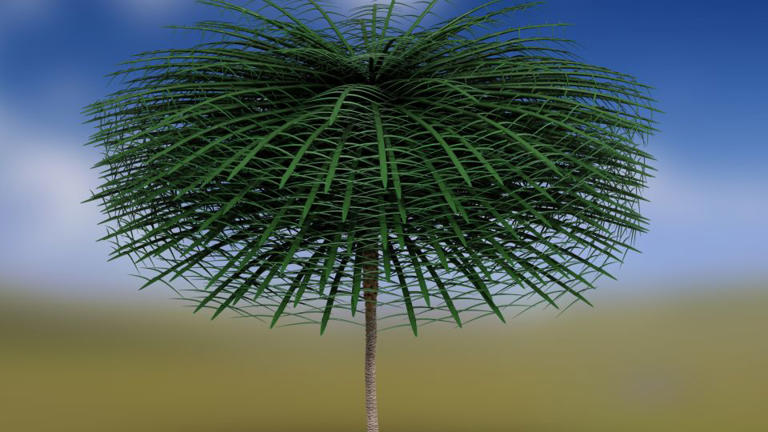Five tree fossils buried alive by an earthquake 350 million years ago were found in a quarry in the Canadian province of New Brunswick, according to a study published Friday in the journal Current Biology. The authors said these new and unusual fossil trees not only bear a surprising shape reminiscent of a Dr. Seuss illustration, they reveal clues about a period of life on Earth of which we know little. “They are time capsules,” said Robert Gastaldo, a paleontologist and sedimentologist who led the study, “literally little windows into deep-time landscapes and ecosystems.”
Coauthors Olivia King and Matthew Stimson unearthed the first of the ancient trees in 2017 while doing fieldwork in a rock quarry in New Brunswick. One of the specimens they discovered is among a handful of cases in the entire plant fossil record — spanning more than 400 million years — in which a tree’s branches and crown leaves are still attached to its trunk.
Few tree fossils that date back to Earth’s earliest forests have ever been found, according to Gastaldo. Their discovery helps fill in some missing pieces of an incomplete fossil record.
“There are only five or six trees that we can document, at least in the Paleozoic, that were preserved with its crown intact,” said Gastaldo, a professor of geology at Colby College in Waterville, Maine.

To: Carriage Hill
That would definitely be an interesting tree to have in one’s yard.
2 posted on
04/25/2024 5:10:11 AM PDT by
Twotone
(We have to stop punishing ourselves for considering things that once seemed crazy. - B. Weinstein)
To: Carriage Hill
The researchers excavated the first fossil tree about seven years ago, but it took another few years before four more specimens of the same plant were found in close proximity to one another. Dubbed “Sanfordiacaulis,” the newly identified species was named in honor of Laurie Sanford, the owner of the quarry where the trees were unearthed.
The forms taken by these previously unknown 350 million-year-old plants look somewhat like a modern-day fern or palm, per the study, despite the fact that those tree species didn’t appear until 300 million years later. But while the tops of ferns or palms as we know them boast few leaves, the most complete specimen of the newly discovered fossils has more than 250 leaves preserved around its trunk, with each partially preserved leaf extending around 5.7 feet (1.7 meters).
That fossil is encased in a sandstone boulder and roughly the size of a small car, according to Stimson, an assistant curator of geology and paleontology at the New Brunswick Museum.
The unique fossilization of the cluster of trees is likely due to a “catastrophic” earthquake-induced landslide that took place in an ancient rift lake, he said.
“These trees were alive when the earthquake happened. They were buried very quickly, very rapidly after that, at the bottom of the lake, and then the lake (went) back to normal,” Stimson said.
Finding complete fossil trees is rare and much less common than finding a complete dinosaur, according to Peter Wilf, a professor of geosciences and paleobotanist at Pennsylvania State University who was not involved with the study. Wilf noted via email that the “unusual” new fossil tree was a relic of a time period from which there are almost no tree fossils.
“The new fossils are a milestone in our understanding of how early forest structure evolved, eventually leading to the complex rainforest architectures that support most of Earth’s living biodiversity,” Wilf added.
3 posted on
04/25/2024 5:10:49 AM PDT by
Carriage Hill
(A society grows great when old men plant trees, in whose shade they know they will never sit.)
To: Carriage Hill
Isn’t that different! It’s almost a palm tree.
4 posted on
04/25/2024 5:11:51 AM PDT by
PrairieLady2
(USA: Land of the free, Because of the Brave.)
To: Carriage Hill
5 posted on
04/25/2024 5:13:05 AM PDT by
Red Badger
(Homeless veterans camp in the streets while illegals are put up in 5 Star hotels....................)
To: Carriage Hill
It’s hard to imagine a world without trees. And the poor termites would have very little to eat.
8 posted on
04/25/2024 5:24:18 AM PDT by
smokingfrog
( sleep with one eye open (<o> --- )
To: Carriage Hill
Can’t they just watch old re-runs of ‘The Flintstones’ to look at the trees of the time? ;)
Interesting stuff. Nature always wins. :)
9 posted on
04/25/2024 6:00:15 AM PDT by
Diana in Wisconsin
(I don't have, 'Hobbies.' I'm developing a robust Post-Apocalyptic skill set. )
To: Carriage Hill
They had quarries 350 million years ago?
11 posted on
04/25/2024 6:16:21 AM PDT by
Delta 21
(If anyone is treasonous, it is those who call me such.)
To: Carriage Hill
I want to know what it looks like quarter sawn, and should I use shellac or BLO?
14 posted on
04/25/2024 6:27:43 AM PDT by
Joined2Justify
(Sorry to be optimistic, but...)
To: Carriage Hill
FR should make a rule that you have to post the actual story, not send people through an inferior and multiple click version of it at a leftwing portal.
17 posted on
04/25/2024 6:40:25 AM PDT by
ansel12
((NATO warrior under Reagan, and RA under Nixon, bemoaning the pro-Russians from Vietnam to Ukraine.))
To: Carriage Hill
Not so different than a palm tree. The palmiform layout has evolved many times.
Here is an almost extinct cyad tree

Here is a Norfolk tree fern Forest

And let's not forget the Joshua tree which is a type of yucca.

24 posted on
04/25/2024 7:52:19 AM PDT by
wildcard_redneck
(He who sacrifices freedom for security deserves neither.)
FreeRepublic.com is powered by software copyright 2000-2008 John Robinson




